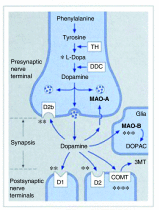Recent advances in treating Parkinson's disease
- PMID: 28357055
- PMCID: PMC5357034
- DOI: 10.12688/f1000research.10100.1
Recent advances in treating Parkinson's disease
Abstract
This article summarizes (1) the recent achievements to further improve symptomatic therapy of motor Parkinson's disease (PD) symptoms, (2) the still-few attempts to systematically search for symptomatic therapy of non-motor symptoms in PD, and (3) the advances in the development and clinical testing of compounds which promise to offer disease modification in already-manifest PD. However, prevention (that is, slowing or stopping PD in a prodromal stage) is still a dream and one reason for this is that we have no consensus on primary endpoints for clinical trials which reflect the progression in prodromal stages of PD, such as in rapid eye movement sleep behavior disorder (RBD) -a methodological challenge to be met in the future.
Keywords: Parkinson's disease; disease modifying treatment; motor symptoms; non-motor symptoms; prodromal stage.
Conflict of interest statement
Competing interests: The author declares that he has no competing interests.No competing interests were disclosed.No competing interests were disclosed.
Figures


References
-
- Lewy FH: Paralysis agitans. I. Pathologische Anatomie.In: Handbuch der Neurologie(Lewandoski M, Hrsg), Springer Berlin. III:920–933.
-
- Tretiakoff C: Contribution a l'etude l'anatomie pathologique du locus Niger de soemmering: avec quelques déductions relatives à la pathogénie des troubles du tonus musculaire et de la maladie de Parkinson. Jouve Paris.1919. Reference Source
-
- Birkmayer W, Hornykiewicz O: [The L-3,4-dioxyphenylalanine (DOPA)-effect in Parkinson-akinesia]. Wien Klin Wochenschr. 1961;73:787–8. - PubMed
Publication types
LinkOut - more resources
Full Text Sources
Other Literature Sources
Miscellaneous

